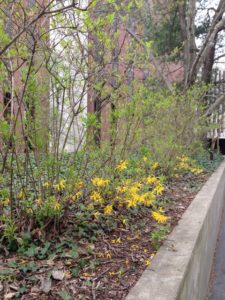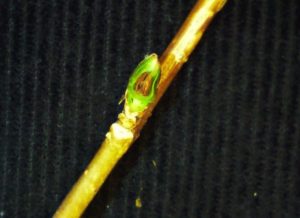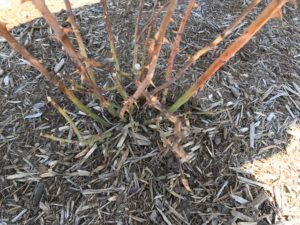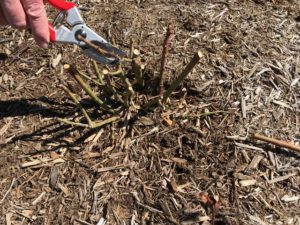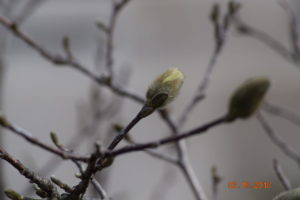Winter of 2017-18 was pretty harsh compared to most years. Much of central and northern Indiana experienced 13 or more days well below 0º F, while southern Indiana had 4- 5 days just a few degrees below 0º F. In addition, gusty winds contributed to further injury by desiccation of buds and twigs.
The consequences still remain to be seen. While some spring flowering trees and shrubs may perform admirably this season, some species will have few or no blooms at all, particularly in the northern half of the state. In addition, some plants may be late to leaf out leaving us concerned that they died overwinter.
Some shrubs such as forsythia may flower only on the lower branches, where snow cover and leaf litter provided good insulation (Fig. 1). But for many specimens, there may be no flowers at all. A recent check of buds on forsythia plants on the Purdue West Lafayette campus revealed significant flower bud damage, evidenced by a brown center in the bud (Fig. 2).
- Figure 1. Forsythia blooms survived only on lower branches. Photo: Rosie Lerner, Purdue Extension
- Figure 2. Brown center of forsythia bud indicating cold injury. Photo: Bruce Bordelon, Purdue Extension
Many roses have experienced considerable dieback, some nearly to the ground (Fig. 3). Some of these roses will still be able to bloom on new twigs that develop later this spring. It is recommended to prune out the dead wood on the roses (Fig. 4).
- Figure 3. Winter dieback on roses. Photo: Rosie Lerner, Purdue Extension
- Figure 4. Prune to remove winter dieback on rose twigs. Photo: Rosie Lerner, Purdue Extension
For other plants such as magnolia and lilac, our bud checks look pretty good, but there’s still more weather to get through before we know for sure (Fig. 5). Marginally cold hardy plants that have performed well the past several years may experience significant dieback due to the extreme low temperatures.
While it is still possible that these plants may continue to show effects of the harsh winter, most should recover and return to normal blooming next year – assuming reasonable weather. Some plants may break bud and show no symptoms of cold injury, but later will develop drought symptoms. When this occurs, it is usually indicative of root freezing injury.
We recommend conservative pruning to remove only dead branches and conserve as much foliage as possible, so that plants can maximize leaf area for photosynthesis to aid recovery. This can be performed after foliage bud break.
Being proactive, by informing your clients of this possibility, is advisable so that they aren’t caught off-guard when some of their plantings don’t bloom as normal.
If you suspect another problem to your plants, or to confirm cold injury, you can submit samples to the Purdue Plant and Pest Diagnostic Lab: https://ag.purdue.edu/btny/ppdl/Pages/default.aspx.
